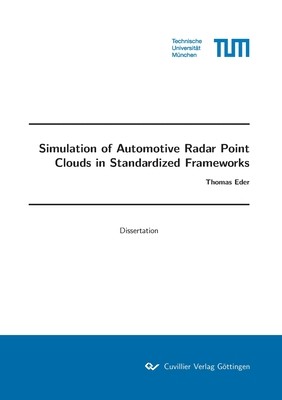
- We will send in 10–14 business days.
- Author: Thomas Eder
- Publisher: Cuvillier
- ISBN-10: 3736975368
- ISBN-13: 9783736975361
- Format: 14.8 x 21 x 0.7 cm, softcover
- Language: English
- SAVE -10% with code: EXTRA
Simulation of Automotive Radar Point Clouds in Standardized Frameworks (e-book) (used book) | bookbook.eu
Reviews
Description
The simulation of the vehicle's environmental sensors, the so-called sensor simulation, is crucial for testing and validating autonomous driving. Automobile manufacturers are increasingly focusing on a standardized architecture with a high level of abstraction. In order to simulate the sensors, such as radar sensors, most realistically on a point cloud level, data-based methods are used in many cases. In general, and specifically in case of radar sensors, there are still challenges to be faced. Therefore, four research questions are addressed: Is it possible to generate synthetic training data for data-based models? Which statistical approaches are suitable to simulate radar point clouds and how shall their learning capacities be evaluated? Is there a modeling approach to circumvent the disadvantages of statistical modeling? How to tackle the statistical nature of radar sensors during validation?
EXTRA 10 % discount with code: EXTRA
The promotion ends in 20d.02:01:53
The discount code is valid when purchasing from 10 €. Discounts do not stack.
- Author: Thomas Eder
- Publisher: Cuvillier
- ISBN-10: 3736975368
- ISBN-13: 9783736975361
- Format: 14.8 x 21 x 0.7 cm, softcover
- Language: English English
The simulation of the vehicle's environmental sensors, the so-called sensor simulation, is crucial for testing and validating autonomous driving. Automobile manufacturers are increasingly focusing on a standardized architecture with a high level of abstraction. In order to simulate the sensors, such as radar sensors, most realistically on a point cloud level, data-based methods are used in many cases. In general, and specifically in case of radar sensors, there are still challenges to be faced. Therefore, four research questions are addressed: Is it possible to generate synthetic training data for data-based models? Which statistical approaches are suitable to simulate radar point clouds and how shall their learning capacities be evaluated? Is there a modeling approach to circumvent the disadvantages of statistical modeling? How to tackle the statistical nature of radar sensors during validation?


Reviews